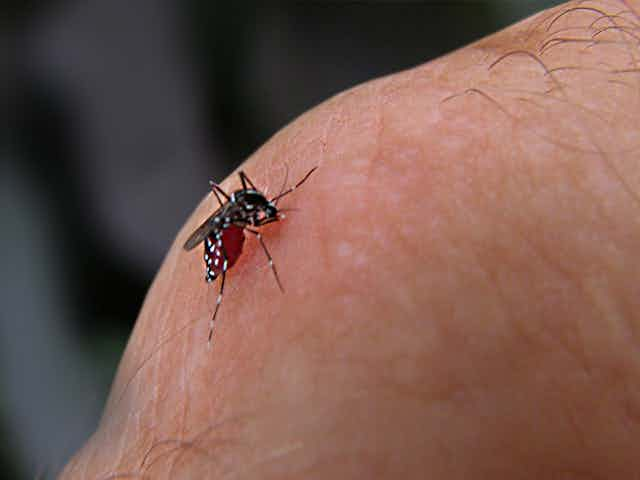You might have heard the term flavivirus recently due to the outbreak of Zika virus in Central and South America. Zika, along with West Nile virus, dengue, yellow fever and Japanese encephalitis, belongs to this family of virus – of which many are threats to public health.
Flaviviruses are defined by the shape and size of the virus particle (which is extremely small and not visible by the naked eye but requires a high powered electron microscope). They are able to replicate and spread within both insects and mammals, and they infect humans and domesticated animals.
How are flaviviruses spread?
Flaviviruses are arboviruses, which means they are spread via infected arthropod vectors such as ticks and mosquitoes.
Some flaviviruses (such as West Nile) exist in a bird-mosquito cycle and infections in humans are typically incidental and a “dead-end” for the virus. This means it cannot be transmitted to a new mosquito.
However, yellow fever, dengue and Zika exist predominantly in a human-mosquito cycle. These viruses grow very well in the human body and therefore allow the re-infection of mosquitoes.
The geographical location of flaviviruses is determined primarily by the distribution of the mosquito or tick vector. For the most part, they are confined to tropical and sub-tropical regions, particularly Southeast Asia and South America. However, Australia has two native flaviviruses – Murray Valley encephalitis and its own strain of West Nile called “kunjin”. Australia also has epidemic episodes of dengue occurring in far North Queensland.
The Aedes aegypti mosquitoes responsible for spreading Zika and yellow fever have been shown to be able to adapt in high-density urban areas, which means it is important to find methods to contain flaviviruses. The urbanisation of the ever-growing human population and the impact of climate change are increasing the population at risk of contracting flavivirus infections.
How do they attack the body?
A flavivirus is transmitted via the bite of an infected tick or mosquito. It enters the bloodstream and invades and infects cells called monocytes in the immune system. The virus is then transported to lymph nodes and targets organs within the body, where different flaviviruses cause different symptoms.

Symptoms generally take seven days to appear and can last for an additional seven days. Some flaviviruses, such as West Nile, can enter the brain and induce encephalitis, whereas yellow fever infects the liver, dengue can cause shock and haemorrhage within the body, and Zika induces joint and muscle pain upon infection.
It is not currently understood why these symptoms occur, but we’re conducting research to try to uncover how the viruses affect the body.
Are there treatments?
Currently vaccines are available for some flaviviruses – including yellow fever, Japanese encephalitis and tick-borne encephalitis virus. A vaccine for dengue was recently licensed for use in Brazil, the Philippines and Mexico.
The development of a dengue vaccine has been challenging due to the different variations of the virus. Being exposed to one type potentially worsens subsequent infections with another type of the same virus. To avoid this complication, the current vaccine trials have included all four dengue variations in their formulations.
A recent advancement in controlling flaviviruses is with the use of a bacterium called Wolbachia. Mosquitoes that harbour this bacteria are completely resistant to subsequent flavivirus infection, and the bacteria can infect and remain persistent within mosquito populations.
If flaviviruses can’t establish infection within the vector host, this limits its maintenance in the environment. The Doherty Institute, along with Monash and Oxford University, is researching implementation of this form of biological control.

